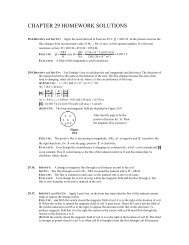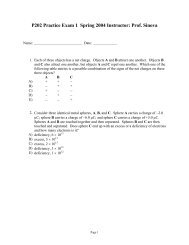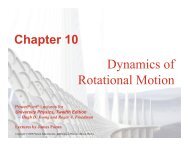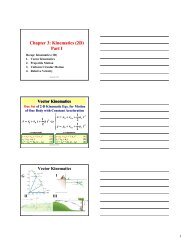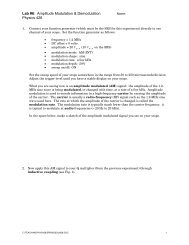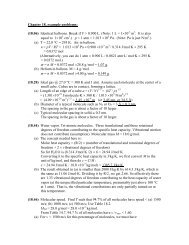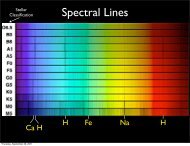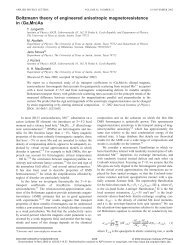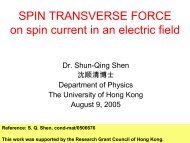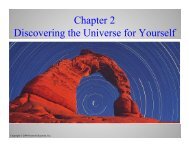Rotational Motion
Rotational Motion
Rotational Motion
You also want an ePaper? Increase the reach of your titles
YUMPU automatically turns print PDFs into web optimized ePapers that Google loves.
<strong>Rotational</strong> <strong>Motion</strong>I. <strong>Rotational</strong> KinematicsII. <strong>Rotational</strong> Dynamics(Netwton’s Law for Rotation)III. Angular Momentum Conservation<strong>Rotational</strong> <strong>Motion</strong>1. Remember how Newton’s Laws for translationalmotion were studied:1. Kinematics (x = x 0 + v 0 t + ½ a t 2 )2. Dynamics (F = m a)3. Momentum Conservation2. Now, we repeat themagain, but for rotationalmotion:1. Kinematics (θ, ω, α)2. Dynamics (τ = I α)3. Angular MomentumPart I<strong>Rotational</strong> <strong>Motion</strong>Translational <strong>Motion</strong> and<strong>Rotational</strong> <strong>Motion</strong>Today Later1
Newton’s s Laws for Rotation τ = Iαnet2 nd part1 st part3rd part<strong>Rotational</strong> <strong>Motion</strong>Angular QuantitiesKinematical variables to describe the rotational motion:Angular position, velocity and accelerationlθ = ( rad)R∆θdθω = lim =∆t→0∆t dtωave∆ωdωα = lim =∆t→0∆t dtαave( rad/s)( rad/s2)<strong>Rotational</strong> <strong>Motion</strong>2
Linear and Angular Quantitiesa tana rad<strong>Rotational</strong> <strong>Motion</strong>Vector Nature ofAngular QuantitiesKinematical variables to describe the rotational motion:Angular position, velocity and accelerationc.w. or c.c.w. rotation (like +x or –x direction in 1D)Vector natures!lθ =Rdkˆθω = kˆdtdkˆωα = kˆdt( rad)( rad/s)( rad/s>0 or
Example 1 ( (α = constant)(1) What is the angular speed of rotation of the Earth?1 rotation (2π rad) per 24 hours (1440 min)(2) An old 33 1/3 rpm record player starts from rest andreaches operating speed in 2.00 seconds. Through whatangle did it turn in those 2.00 seconds?t = 2.00 s, ω 0 = 0, ω = 33 1/3 rpm(3) A computer hard drive rotates at 5400 rpm. Whatangular acceleration will get it up to speed in just 150revolutions starting from rest?Use Eq. (3) with θ – θ 0 = 150 rev. = ? rad<strong>Rotational</strong> <strong>Motion</strong>Example 1 (cont’d)(4) A hard drive reaches 5400 rpm in 3.20 seconds. Whatwas the average angular speed assuming constantangular acceleration?(5) A dentist’s drill accelerates to 1800 rpm in 2.50 seconds.what is its angular acceleration?(6) The angular velocity changes from 47.0 rad/s to –47.0rad/s in 2.00 seconds. What is the angular acceleration?<strong>Rotational</strong> <strong>Motion</strong>4
Example 2A grinding wheel turns at a constant angular accelerationof 60.0 rad/s 2 from 24.0 rad/s for 2.00 sec. Then, acircuit breaker trips. It turns through 432 rad as it coaststo a stop at a constant angular acceleration.Find:(a) the total angle between t = 0and the time it stopped;(b) the time it stopped;(c) the angular acceleration as itslowed down.Also sketch θ-t graph.<strong>Rotational</strong> <strong>Motion</strong>Practice Problem 1Problem 3: (25 points)A grinding wheel turns at a varying angular acceleration of α(t) = [30.0 rad/s 3 ] t for 2.00sec. Assume the initial angular speed of 20.0 rad/s. Then, a circuit breaker trips. It turnsthrough 400 rad as it coasts to a stop at a constant angular acceleration.a. (5 pts) Find the total angle (θ total ) between t = 0 and the time it stopped.b. (10 pts) Find the time (t total ) it stopped. Find the angular acceleration as it slowed down.c. (10 pts) Sketch θ−t, ω-t, α-t graphs.<strong>Rotational</strong> <strong>Motion</strong>5
Practice Problem 2A solid cylinder (radius R = 2 m and height H = 5 m) turns at aconstant angular acceleration of 60.0 rad/s 2 from 24.0 rad/sfor 2.00 sec. Then, a circuit breaker trips. It turns through432 rad as it coasts to a stop at a constant angular acceleration.(a) Find the total angle between t = 0and the time it stopped.(b) Find the time it stopped.(c) Find the angular accelerationas it slowed down.0.4H(d) Find the speed (v) of point Pat t = 2.00 sec.(e) Sketch the motion of point Pin v-t graph. Also sketch θ-t graph.ωH<strong>Rotational</strong> <strong>Motion</strong>1. Remember how Newton’s Laws for translationalmotion were studied:1. Kinematics (x = x 0 + v 0 t + ½ a t 2 )2. Dynamics (F = m a)3. Momentum Conservation2. Now, we repeat themagain, but for rotationalmotion:1. Kinematics (θ, ω, α)2. Dynamics (τ = I α)3. Angular MomentumPart II<strong>Rotational</strong> <strong>Motion</strong>Translational <strong>Motion</strong> and<strong>Rotational</strong> <strong>Motion</strong>Today Later6
Torque due to Gravity? τ = r × F= ?We assume:Center of mass (CM or cm)= Center of gravity(if uniform gravity)<strong>Rotational</strong> <strong>Motion</strong>Torque due to Gravity? τ = r × F= ?mass m<strong>Rotational</strong> <strong>Motion</strong>7
Net Torque due to Gravity?One extra sphere!Do we need a new concept?No!mass mlτnet= τrod+ τsphereSolid sphere (M, r)<strong>Rotational</strong> <strong>Motion</strong>ττ = Fnet2( R 22⋅Note: sign of τ and Σττ 1= F 1( R 1sin90 )= (50.0N)(0.300 m) = 15.0N⋅m= (50.0N)(0.500 m)(0.866)= 21.7N m = τ [c.c.w.]+ τ [c.w.]1= τ [ + 1] + τ [ −1]1sin60 )22= [(15.0N⋅m)− (21.7N⋅m)][c.c.w.]= − 6.7N⋅m[c.c.w.]→6.7N⋅m[c.w.]<strong>Rotational</strong> <strong>Motion</strong>r 1r 28
Example 1Calculate the torque on the 2.00-m longbeam due to a 50.0 N force (top) about(a) point C (= c.m.)(b) point PCalculate the torque on the 2.00-m longbeam due to a 60.0 N force about(a) point C (= c.m.)(b) point PCalculate the torque on the 2.00-m longbeam due to a 50.0 N force (bottom) about(a) point C (= c.m.)(b) point P<strong>Rotational</strong> <strong>Motion</strong>Example 1 (cont’d)Calculate the net torque on the 2.00-mlong beam about(a) point C (= c.m.)(b) point P<strong>Rotational</strong> <strong>Motion</strong>9
Ptactice Problem 2Determine the net torque (magnitude and direction) on the2.00-m-long beam about:50.0 Na. (15 pts) point C (the CM position);θ = 70.0b. (10 pts) point P at one end.o τi= ri× Fi= ? τ τnet=ii60.0 Nθ = 50.0 oCPθ = 33.0 o<strong>Rotational</strong> <strong>Motion</strong>50.0 NPtactice Problem 2Determine the net torque (magnitude and direction) on thedisk about pin. τi= ri× Fi= ? τ τnet=iiF 1= 50Nθ 1 =40 oθ 2 =70 oF 2= 25N<strong>Rotational</strong> <strong>Motion</strong>10
Newton’s s Laws for Rotation τ = Iαnet2 nd part[N m]3rd part1 st part[s –2 ]<strong>Rotational</strong> <strong>Motion</strong>Parallel-axis axis Theoremd 22d 1I = I 1+ I<strong>Rotational</strong> <strong>Motion</strong>11
2(a) Express the moment of inertia of the array of pointobjects about the y-axis in terms of m, M, X 1 , X 2 , and/orY.X 1 X 2Y<strong>Rotational</strong> <strong>Motion</strong>Newton’s s Laws for Rotation τ = Iαnet2 nd part[N m]3 rd part[kg m 2 ]1 st part[s –2 ]K rot = (1/2) I ω 2 ( K = (1/2) m v 2 )Application?<strong>Rotational</strong> <strong>Motion</strong>12
Rolling <strong>Motion</strong> (w/o slipping)“PHYSICS,” R. Serway and R. Beichner, 5 th ed.<strong>Rotational</strong> <strong>Motion</strong>Rolling <strong>Motion</strong> w/o Slipping (2)ωωFaster<strong>Rotational</strong> <strong>Motion</strong>Instantaneously restInstantaneous axis13
Example 3What will be the speed of each of the following objects whenit reaches the bottom of an incline if it starts from rest at avertical height H and rolls without slipping? Find the speedusing the conservation of mechanical energy.(i) Solid sphere (M, R 0 )(ii) Solid cylinder (M, R 0 , l)(iii) Thin hoop (M, R 0 , l)<strong>Rotational</strong> <strong>Motion</strong>Example 4Analyze the rolling sphere in terms of forces and torques: findthe magnitudes of the velocity v and the friction force F fr .1. F.B.D.?Rolling <strong>Motion</strong>(w/o slipping)2. Is F fr static or kinetic friction?Static FrictionNo workNo energy lossK+U=constant<strong>Rotational</strong> <strong>Motion</strong>P is:(a) the point of contact with theground;(b) instantaneously rest relativeto the ground.Thus:The motion of the wheel is a purerotation about the instantaneousaxis through P at the instant.<strong>Rotational</strong> <strong>Motion</strong>14
Example 5A sting is wrapped arounda uniform solid cylinder ofmass M (= 0.500 kg) andradius R (= 0.200 m), andthe cylinder starts fallingfrom rest. Draw the freebodydiagram for thecylinder while it descends.A l s o f i n d ( a ) i t sacceleration, (b) the tensionin the string, and (c) thespeed after the cylinder hasdescended h = 0.800 m.<strong>Rotational</strong> <strong>Motion</strong>Example 5 - ChallengeA sting is wrapped around a hollow cylinder of mass M(= 0.500 kg), inner radius R 1 (= 0.100 m), outer radiusR 2 (= 0.200 m). The cylinder starts falling from rest.(a) Draw the free-body diagram for the cylinder while itdescends.Also find:(b) its acceleration;(c) the tension in the string;(d) the speed after the cylinder hasdescended h = 0.800 m.<strong>Rotational</strong> <strong>Motion</strong>15



